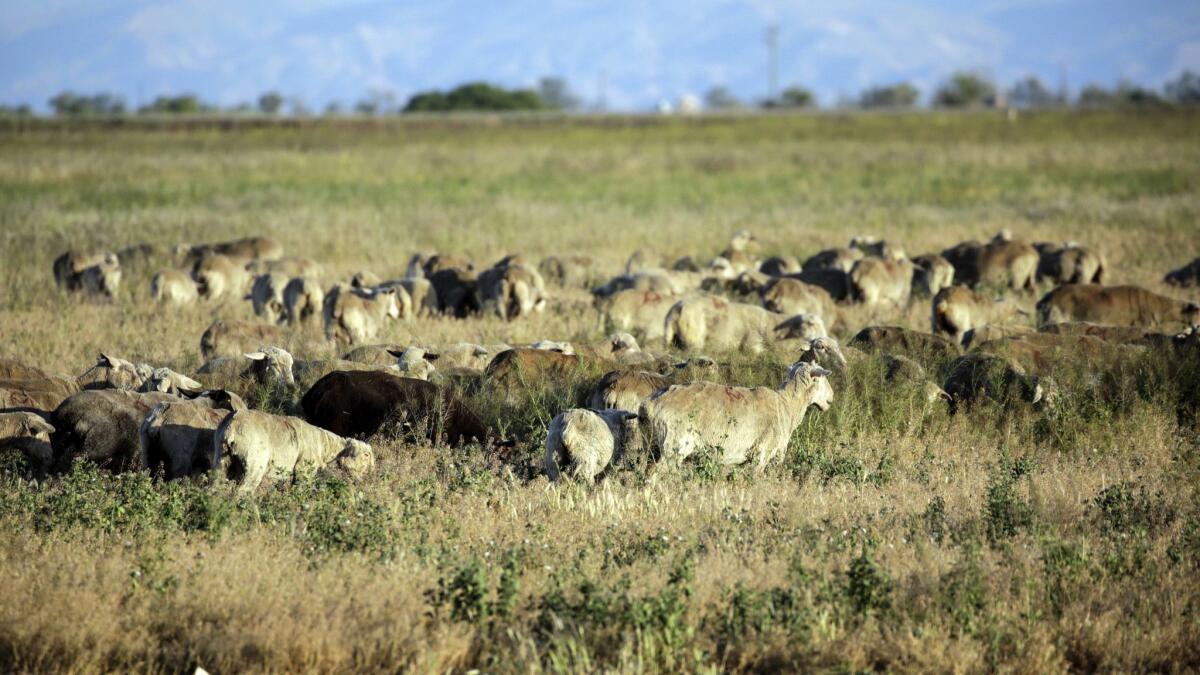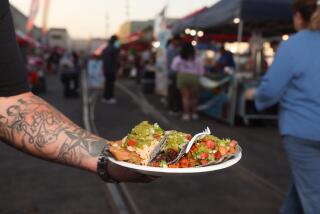To California’s Basque Country, propelled by hydrogen
In May 1968, I took a road trip with my father to see Cesar Chavez and Bobby Kennedy speak in the Central Valley farm town of Delano. Chavez was organizing civil rights for farm workers. Kennedy was campaigning for president. Both men were eloquent and moving.
On the drive back, my father detoured into Bakersfield. He had heard about a Basque restaurant that, like the country inns we both loved in our home state of North Carolina, served big family-style dinners.
It was not oversold. We had one of the best meals of our lives.
Chavez, Kennedy and my father are gone, but the Basque restaurants remain. This spring I took another road trip — solo, this time — to find the place where we had eaten in 1968 and to check out other Basque restaurants.
I left Los Angeles midmorning on a Tuesday, hoping to meet two friends for the first Basque meal of the day. I had a little trepidation. To make the road trip more interesting, I borrowed from Toyota the hydrogen fuel cell Mirai, which was sleek, silent and powerful and boasted a range of 310 miles per tank.
As I left a hydrogen filling station in Hollywood, the gauge indicated the range as 238 miles. That was enough to get me to Bakersfield and back but barely, because there are no hydrogen stations there or on the route up or back. The Toyota folks insisted the car was good for 310 miles and said I shouldn’t worry, so off I went.
I had driven an earlier model Mirai and found this newer version even quieter and more powerful. It drove and handled just like any midsized sedan. But for the pleasant silence, I soon forgot I was driving such a technologically advanced vehicle that was also filled with hydrogen fuel.
Good eats at Benji’s
By noon, I was at Benji’s French Basque Restaurant west of Bakersfield. My friends had already consulted the menu. We chose veal sweetbreads, garlic fried chicken and lamb kebab. Soon we were elbow deep in good eats, amid paintings depicting Basque scenes.
Basque shepherds started coming to the Central Valley in mid-1800s, drawn here by the promise of work herding and shearing sheep for local ranchers. As in the old country — or countries, because the Basque provinces in the Pyrenees mountains spread across the French-Spanish border — the shepherds would come to town periodically to draw their pay, get a hotel room and eat a family-style hotel meal.
Benji’s does not serve family style, but many of the traditional Basque staples were included as part of the lunch “set-up” that accompanied each entree — the Basque Holy Trinity of cabbage soup, pinto beans and salsa, eaten together in the same soup bowl, served with fresh bread and butter and succeeded by plates of vinegared tomatoes, green salad and French fries. And that was just the set-up.
Benji’s felt pleasantly upscale, with its soft lighting and linen napkins, but at noon on a Tuesday, it was nearly empty. The soup wasn’t as hearty as I remembered it from my childhood, but the sweetbreads were excellent, and the chicken was served with enough garlic to cure a thousand head colds.
Leaving Benji’s, I noticed I had only 162 miles of range left on the Mirai. Still plenty, but not enough to quell my rising “range anxiety.”
There are plenty of stations in Southern California — 24 of the state’s 39 are south of Santa Barbara, but most of those are in the greater L.A. area. There was not one in the San Joaquin Valley. In fact, the closest was in La Cañada Flintridge, almost where I had started the drive.
I distracted myself with a visit to Dewar’s (pronounced “Dwars”) a candy shop/ice cream parlor founded in 1909 that is a Bakersfield institution. I sat on a red-leatherette stool at the counter and nibbled at a scoop of English toffee, one of 23 flavors. It was excellent, but with a belly full of Basque lunch I would have done better ordering half a scoop.
I had booked four seats for dinner at Noriega’s Hotel and Restaurant, for which I would need renewed appetite and strength. Because Noriega’s doesn’t rent rooms anymore, I checked into the Padre Hotel, another Bakersfield institution, hoping for an afternoon nap.
That proved easy. The Padre, which opened in 1928 with 198 guest rooms, underwent a massive rehabilitation in 2010. Although it still looks stately and old on the outside, it is modern and elegant on the inside. The rooms have nicknames (I was in “Head Honcho,” next door to “Oil Baron”) and are decorated in a spare style. It was easy to settle in and grab 40 winks.
Family-style meals
At 6:30 I was at the bar attached to Noriega’s, which dates to 1898. It still serves family-style lunches and dinners; there is one seating for each meal and one price. Diners lubricate their appetites at the bar, often with a glass of the Basque highball known as Picon Punch, a mule kick of a cocktail made with brandy, grenadine and a bitter apéritif called Amer Picon.
Then they take their seats at the three long tables in the dining room for a meal that delighted the late Jonathan Gold, then writing for the LA Weekly and later the revered food critic at the Los Angeles Times.
A dozen other diners joined us on that Tuesday night. The family-style tables, each big enough to seat 60 people or more, were laden with plates of pickled tongue and tomatoes and onions in vinaigrette, alongside slabs of blue cheese, baskets of sliced French bread and bottles of chilled red wine.
Road trip on a Tesla on Nevada’s Electric Highway »
Soon came the tureen of cabbage soup, served with beans and salsa, followed by a bowl of iceberg lettuce salad, a plate of cottage cheese, platters of green beans and a basket of marvelous French fries, clearly fried in animal fat.
Then came spaghetti in red sauce. Then chicken cacciatore. Then the main course – fat rib-eye steaks dotted with bits of roasted garlic. (The entrées change nightly and could be spare ribs, oxtail stew, fried chicken and more.)
Despite my heavy lunch, I found room for a second helping of the splendid soup, quickly becoming my favorite part of the basic Basque meal, and a second piece of the steak. I rolled out feeling like the Michelin Man.

Morning means coffee
I arose the next morning rested and ready for more. I grabbed a coffee at the Padre’s Farmacy Lobby Café, took a short walk past the 1970s-era Greyhound Station and the offices of the Bakersfield Californian newspaper, and had a light breakfast at Happy Jack’s Pie n Burger, just to keep my hand in, so to speak.
Then it was lunchtime. Determined to complete the field research and make the most of my road trip, I doubled up.
I started next door to Noriega’s, at the Pyrenees Cafe, also dating to the early Bakersfield Basque days. The Pyrenees now serves standard fare along with Basque specialties and feels more like a saloon than a restaurant.
Are we recreational vehicle people? Hell, yeah! »
I sat in the dim barroom light, listening to “Bakersfield Sound” cuts from Merle Haggard and Buck Owens and their musical offspring, and sampled a serving of soup, beans, salsa and fresh bread. (As is the case in many of the Basque joints, these loaves came from the nearby Pyrenees Bakery, another local institution but not affiliated with the cafe.)
Lunch and dinner specials include standards such as lamb shank, oxtail stew and prime rib, available at “American” and “Basque” prices — higher for the latter, because they include the full set-up (bread, soup, etc.) I wasn’t up to that, and the two women working the bar seemed to find it comical that anybody would want soup, beans and salsa at 11 in the morning, with no booze to back it up, but they served me anyway.
That primed me for a proper meal. I got it at Wool Growers Restaurant, where the waitress’s first question was, “Are you having soup today?” This was code, I learned, for the full menu.
I didn’t think I could eat an entire lunch, but I needed to taste the soup. For a fair comparison with Benji’s, I ordered the garlic fried chicken.
The soup, accompanied by the beans and salsa, was the best I had eaten yet. The fried chicken was a perfect combination of moist inside and crispy outside. The fries were the second best I’d had, after Noriega’s. And the room, except for one medium-sized family style table in the center, was full.
Enjoying the historic pictures on the walls, I realized this was where my father had brought me in ’68 but in a new location.
A cup of strong coffee set me up for the drive home. I chose to do it the long way and enjoy some scenery. From Bakersfield, I drove east, past the Cesar Chavez National Monument in Keene and got off the highway for a closer look at the Tehachapi Loop, where locomotives climb a steep grade using a curlicue of track that corkscrews around a mountain.
From there, I went south through the mountains, through a forest of power-generating wind turbines, before dropping into Willow Springs and Rosamond, This had once been a thriving sheep herding community, but Villa Basque, its one long-standing Basque restaurant, is now a sports bar.
Mindful of my shrinking hydrogen reserves, I kept below the speed limit and watched two numbers: distance to my destination and the mile range monitor.
To keep distracted, I replayed the four Basque meals. The winners: Noriega’s for the overall Basque experience, and Wool Growers for the finest food. If I had to refine that, I’d choose a Wool Growers lunch and a Noriega’s dinner.
I managed to get to the northernmost LA-area filling station in La Cañada Flintridge. The gauge indicated I had 12 miles of driving left. I topped up and finished the drive home.
If you go
Benji’s French Basque Restaurant, 4001 Rosedale Highway, Bakersfield; (661) 328-0400. Lunch 11:30 a.m.-2:30 p.m.; Dinner 5-9 p.m. daily; closed Mondays. Lunch main dishes $15-$24. Set-up only, $13.50. Dinner main dishes $21-$32. Set-up, $16.
Noriega’s, 525 Sumner St., Bakersfield; (661) 322-8419, 7-9 a.m. and noon to 10 p.m. daily, daily; closed Mondays. Fixed price breakfast $11; fixed price lunch $20; fixed price dinner $25
Pyrenees Cafe, 601 Sumner St,, Bakersfield; (661) 323-0053. 8 a.m.-9 p.m. Sundays to Wednesdays; 8 a.m.-10 p.m. Thursdays to Saturdays. Lunch main dishes $15.95 - $27.95. Set-up only $11.95. Dinner main dishes $21.95 – $45.95. Set-up only $15.95
Wool Growers Restaurant, 620 E. 19th St., Bakersfield; (661) 327-9584. Lunch 11:30 a.m.-2 p.m.; dinner 6-9 p.m. daily; closed Sundays. Lunch main dishes $12-$23; Dinner main dishes $18.50-$30. Set-up only, $17
Happy Jack’s Pie n Burger, 1800 20th St., Bakersfield; (661) 323-1661; 6 a.m.-8 p.m. daily; closed Sundays. Breakfast $5.75 - $11; cash only
Padre Hotel, 1702 18th St., Bakersfield; (661) 427-4900. Doubles from $169
More to Read
Sign up for The Wild
We’ll help you find the best places to hike, bike and run, as well as the perfect silent spots for meditation and yoga.
You may occasionally receive promotional content from the Los Angeles Times.







